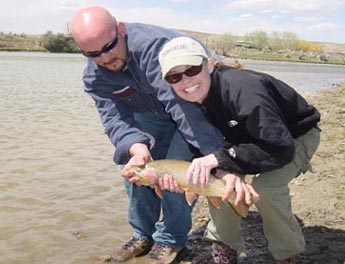If trout can be called voracious in spring, they might best be described as meddlesome in fall. Whether it’s the spawning urge raging in brook and brown trout, or the drive in rainbows to pack on some winter insulation, these fish are operating under new compulsions, and none of them is polite.
The rules that governed late-summer trouting have changed. The same shortened hours of sunlight inspiring the fall foliage on the mountainsides are going to keep the fish in the game all day long as they begin to spawn. This is not to say that water levels and temperatures are unimportant, but the priorities of the trout are shifting, and your methods need to change as well.
First, of course, you have to figure out where they are holding. In late September and throughout October, spawning brookies and browns are not going to be in sandy or silty tailwaters. You’ll find them in the obvious places — pocket waters with good cover nearby and, most important, close to beds of pea-size gravel. Look for them in the faster water where sand cannot settle. Finding the right gravel beds and fishing the adjacent feeding lanes is the most crucial task in your search for good fish, whether the water level is high or low.
You also must be willing to get into the water. While you might be able to hit 50 percent of the sweet spots from the bank, that’s where 75 percent of the other fishermen before you have been, year after year after year. This does not go unnoticed by the trout; they may be somewhat more daring on October 1, but they’re never reckless. So bring your waders or hippers. Better yet, put them on at home before you leave as a reminder of what you should do when you get to your brook.
The path along the bank to where this fish was holding (just above a small bridge) showed strong evidence that Hannibal and his elephants had been by within the last couple of days. I’d been approaching this trout the same way over two seasons, becoming, I felt, ever more cunning, even crawling on my belly to an acceptable fishing position where I sort of dapped my little spinner with no success until, Lo! Why not get into the water behind the bridge and approach from below? I did this and caught the fish on my first good cast. And stealth! You need to be extremely secretive as you wade, which brings me to the next essential.
I promise that if you fish by casting upstream instead of down, you’ll get twice as many strikes. Whether you’re casting small Rapalas, which work very well, spinners (the smallest, unfeathered Mepps are great) or live bait, this is the way to go. Keep your hardware tumbling along, not spinning, just a tad faster than the current, and amazing things will happen if you trail your skirt past a lusty brown or brookie. Be inventive! (You already are, simply by being on the water at this time of year.) Hit the fish from positions they’ve probably never been approached from before.
For artificials, six-pound-test is max, and please snip off at least one of the three hooks (pinched barbs are a good idea, too). With live bait, there are a couple of methods that work well depending on the water conditions. You’ll want to use ultralight gear, and four-pound-test line at most.
If the water is low and clear, crickets and hoppers can’t be beat. Collect the hoppers in the morning when their wet wings prevent them from flying away, and stuff them in a sock pinned under your belt. On the stream, wet the hopper before you do anything else. Though it’s somewhat amusing to watch your very much alive bait fly to the other side of the brook, the trout aren’t in the alders. It happened to me. Once.
But the killer bait for big fall trout is what they like all year long if available: nice, lively minnows. Lugging a minnow bucket around might not be very pleasant, but once you’ve done what I’m going to describe, you’ll never complain again.
First, keep your two-inch critters happy with a change of water every half-hour. Second, buy a vial of the fluorescent orange or green strike indicator putty that flyfishermen use, and press a marble-sized blob about three feet up from your bait. (You should be using size 12 or 14 dry-fly-tying hooks.) The putty will add just a very little weight to your rig, and it will allow your minnow to, there are a couple of methods that work well depending on the water conditions. You’ll want to use ultralight gear, and four-pound-test line at most.
If the water is low and clear, crickets and hoppers can’t be beat. Collect the hoppers in the morning when their wet wings prevent them from flying away, and stuff them in a sock pinned under your belt. On the stream, wet the hopper before you do anything else. Though it’s somewhat amusing to watch your very much alive bait fly to the other side of the brook, the trout aren’t in the alders. It happened to me. Once.
But the killer bait for big fall trout is what they like all year long if available: nice, lively minnows. Lugging a minnow bucket around might not be very pleasant, but once you’ve done what I’m going to describe, you’ll never complain again.
First, keep your two-inch critters happy with a change of water every half-hour. Second, buy a vial of the fluorescent orange or green strike indicator putty that flyfishermen use, and press a marble-sized blob about three feet up from your bait. (You should be using size 12 or 14 dry-fly-tying hooks.) The putty will add just a very little weight to your rig, and it will allow your minnow to

